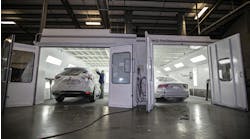Aircraft tire experts urge pilots to adopt routine maintenance program
The most important factor of any aircraft tire maintenance program is ensuring proper inflation pressure, according to Rob Robson, a product support manager at Goodyear, who notes that “the problems created by incorrect inflation can be severe.”
Overinflation often leads to uneven tread wear and reduced traction, makes the tread more susceptible to cutting and places greater stress on aircraft wheels. Underinflation creates faster tread wear on the shoulders, damages the tire’s inner liner and greatly increases the stress and flex heating in the tire that can lead to tire failure, he cautions.
“Because aircraft tire/wheel assemblies can lose up to 5 percent of their pressure each day, they need to be checked daily, or before each flight, with a calibrated pressure gauge when the tire is at ambient temperature – not heated by taxiing,” says Robson. “Any tire that’s been run more than 10 percent underinflated should be removed from service,” he adds.
Robson recommends filling tubeless tires with nitrogen instead of air because it is dry and non-combustible.
The preflight inspection should include checking the tread of each tire because they experience wear during taxi, takeoff and landing. Takeoff generates the most tire wear because the airplane has a full fuel load and the tires are pre-heated by taxiing, says Goodyear’s Larry Rapsard.
“Aircraft tires should be removed when the tread is worn to the base of any groove at any spot, or to the minimum depth stated by the aircraft manufacturer,” he explains.
Tires should also be examined for uneven wear. In cases where gear camber wears one side faster than the other, the tires can be demounted and turned around to extend the tire life. Uneven aircraft tire wear is usually an indication of gear misalignment or tire underinflation.
Rapsard cites other aircraft tire wear conditions revealed through inspection that may require tires to be removed from service. “Sidewall damage including some weatherchecking, cracks or cuts means the tire should be scrapped if the damage extends down to the fabric plies. The same goes for tread cuts and groove cracking,” he explains.
“Damage that doesn’t expose the cords normally does not require the tire to be removed,” Rapsard says.
Excessive operating conditions can cause the tread to wear much faster, such as high energy braking, high speed taxiing and high speed cornering. “Be sure to consider these if you see fast treadwear,” he suggests. “By taking the time to conduct proper inspections and knowing the limits of acceptable aircraft tire wear, you’ll get the most out of your tires.”
Robson reports that another key area of aircraft tire maintenance is making sure no harmful chemicals are used or spilled on the tires. Keep hangar floors clean of all debris to avoid tire damage from foreign objects.
For more information visit www.goodyearaviation.com.




